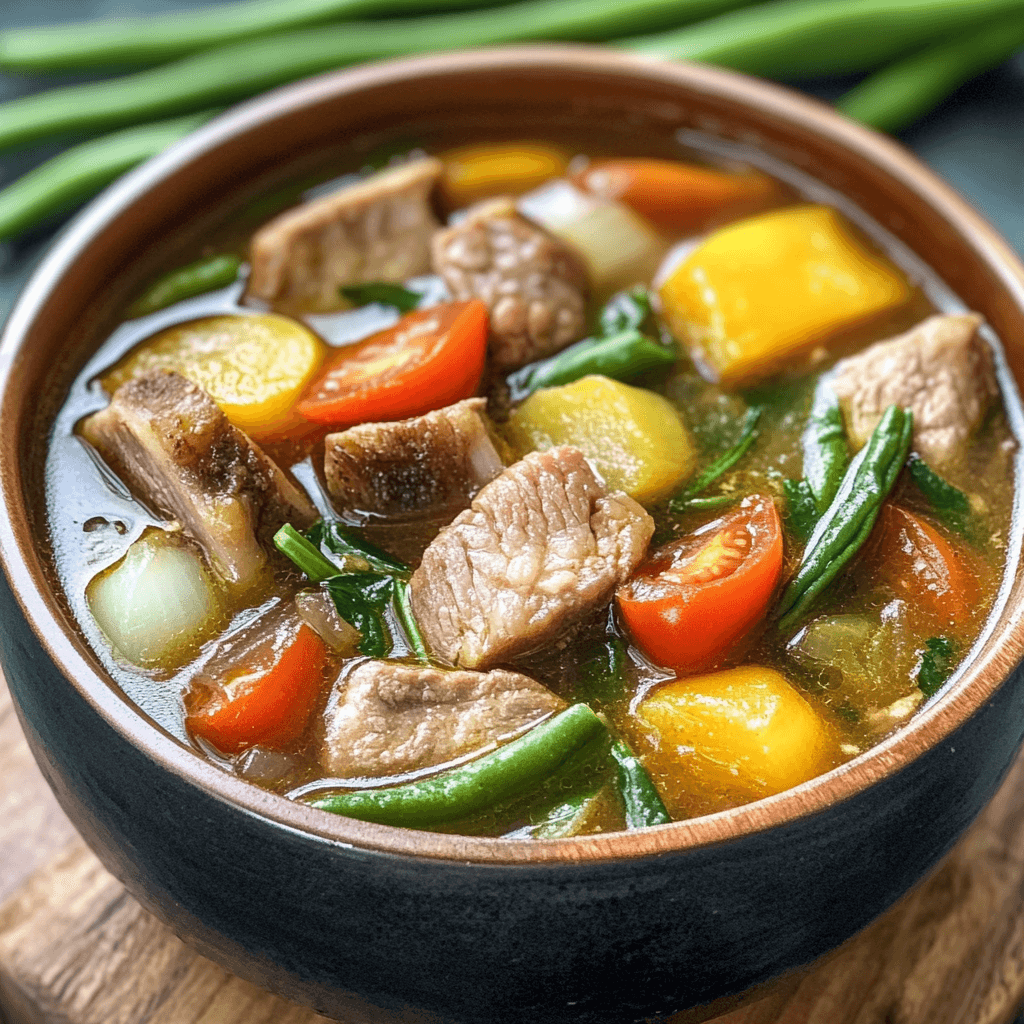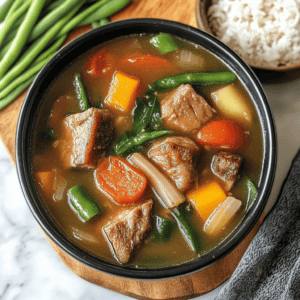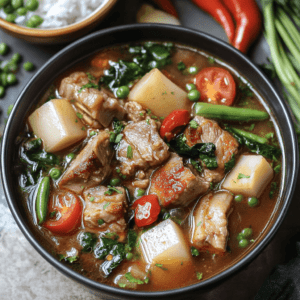Sinigang, a quintessential Filipino dish, stands as a beloved culinary masterpiece known for its tangy, hearty flavors. Perfect for rainy days or family gatherings, this soup-based dish combines the savory richness of meat, the zest of tamarind, and the freshness of vegetables. Crafting a sinigang recipe isn’t just about cooking—it’s about embracing the warmth of tradition and the love of shared meals.
This guide will take you through every aspect of sinigang, from its historical roots to step-by-step instructions, with tips for ensuring the best outcome every time. Whether you’re new to Filipino cuisine or a seasoned home chef, you’ll discover everything you need to create this iconic dish.
Introduction to Sinigang Recipe: A Filipino Culinary Treasure
Sinigang is more than just a dish—it’s a heartfelt expression of Filipino culture and a comforting staple that captures the essence of Filipino cooking. Renowned for its tangy and distinct sour flavor, it symbolizes warmth, unity, and the rich abundance of local ingredients. Its beauty lies in its versatility, as it can be prepared with a variety of ingredients like pork, shrimp, fish, or even guava, allowing it to cater to a wide range of tastes and preferences. Sinigang is not just food; it’s a shared experience, a reflection of home, and a celebration of the vibrant Filipino spirit.
The History of the Sinigang Recipe: A Timeless Filipino Dish
Sinigang has deep roots in the Philippines’ rich agricultural heritage. Tamarind, the key ingredient that gives the dish its signature sourness, is native to tropical regions and has been a cornerstone of Filipino cuisine for centuries. The tangy, flavorful broth reflects the Filipino preference for bold and vibrant tastes. Over the years, sinigang has evolved into an iconic comfort food, cherished for its association with family gatherings, communal meals, and celebrations. Its enduring presence in Filipino households speaks to its cultural significance and its role in bringing people together.
Why Sinigang Recipe is Loved Worldwide by Food Enthusiasts
While many soups worldwide are characterized by creamy or savory bases, sinigang stands out for its distinctly sour and tangy broth. The defining ingredient, tamarind, works harmoniously with an assortment of fresh vegetables to create a flavor profile unique to this dish. Sinigang is more than just a meal—it’s a sensory experience, blending tanginess, umami, and the vibrant freshness of local produce. This perfect balance of flavors makes sinigang a beloved and unforgettable part of Filipino cuisine.
Ingredients Needed for the Perfect Sinigang Recipe
Creating an authentic sinigang begins with selecting the right ingredients. Here’s what you’ll need for a traditional recipe:
Core Ingredients of a Traditional Sinigang Recipe
- Tamarind: Fresh tamarind pods, tamarind paste, or powdered tamarind.
- Protein: Pork belly, shrimp, fish (milkfish or tilapia), or beef ribs.
- Vegetables:
- Tomatoes
- Radish (labanos)
- Eggplant
- Okra
- String beans (sitaw)
- Water spinach (kangkong)
- Aromatics:
- Onion
- Garlic
- Green chili (siling haba)
- Seasoning: Fish sauce (patis) and salt to taste.
How to Choose the Best Tamarind for Your Sinigang Recipe
Tamarind is the soul of sinigang, imparting its distinctive sour and slightly sweet flavor to the broth. Its unique profile defines the dish, making it an essential ingredient. If fresh tamarind is unavailable, substitutes like kamias (bilimbi), calamansi, or lemon juice can be used, but they won’t perfectly replicate the authentic taste. For the most genuine sinigang experience, fresh tamarind is always the preferred choice.
Protein Choices for Sinigang Recipe: Pork, Shrimp, or Fish
- Pork Sinigang: A classic choice, with pork belly or ribs creating a rich and meaty broth that’s deeply satisfying.
- Shrimp Sinigang: Light and refreshing, this version is perfect for seafood lovers, with the natural sweetness of shrimp complementing the tangy broth.
- Fish Sinigang: Ideal for those who prefer a milder flavor, often made with milkfish or tilapia for a delicate and comforting dish.
Essential Vegetables for a Balanced Sinigang
The vegetables in sinigang are just as essential as the protein, contributing texture, flavor, and nutritional value to the dish. Water spinach (kangkong) adds a hint of earthiness, while radish and eggplant provide a touch of subtle sweetness. These ingredients work together to complement the sour broth, creating a harmonious balance that makes sinigang both hearty and wholesome.
Step-by-Step Instructions for Cooking a Sinigang Recipe
Mastering sinigang requires attention to detail. Here’s a foolproof guide:
How to Prepare Ingredients for a Sinigang Recipe
- Clean and Chop: Wash vegetables thoroughly. Slice radish into thin rounds, chop eggplant into chunks, and trim the ends of string beans.
- Tamarind Preparation: Soak fresh tamarind pods in hot water, then mash and strain to extract the juice.
- Protein Prep: For pork, cut into bite-sized pieces; for shrimp, peel and devein.
Cooking the Perfect Tamarind Broth for Your Sinigang Recipe
- Aromatics: In a large pot, sauté onions, garlic, and tomatoes until soft and fragrant.
- Add Tamarind: Pour tamarind juice into the pot, followed by water or broth.
- Simmer: Bring the mixture to a gentle boil, allowing the tamarind to infuse the liquid.
Combining Vegetables and Protein in the Sinigang Recipe
- Add Protein: Drop in the pork, shrimp, or fish, and let it cook through.
- Incorporate Vegetables: Start with the firmer vegetables like radish and eggplant, then add string beans and water spinach closer to the end.
Final Touches and Plating
- Season: Adjust the taste with fish sauce and salt.
- Garnish: Serve with green chili for added heat.
- Serve Hot: Pair with steamed rice for a complete meal.
Variations of Sinigang Recipe to Try
Sinigang is incredibly versatile, with countless regional and personal variations. Each version reflects the unique preferences and available ingredients of the area or individual preparing it. Whether made with pork, seafood, beef, or even exotic local ingredients, sinigang adapts beautifully to diverse tastes while maintaining its core identity as a comforting, tangy dish.
Beef Sinigang
The rich and hearty beef sinigang offers a flavorful twist on the classic Filipino sour soup. Using beef shank, short ribs, or brisket, this version delivers tender, melt-in-your-mouth meat that pairs perfectly with the tangy, savory broth. The slow-cooked beef infuses the soup with deep, robust flavors, making it a comforting and satisfying dish. Loved for its warmth and depth, beef sinigang is a favorite in Filipino households, often enjoyed during family meals and gatherings.
Shrimp Sinigang
This lighter option is an excellent choice for seafood enthusiasts, offering a refreshing and flavorful take on the classic sinigang. Shrimp sinigang highlights the natural sweetness of fresh shrimp, which perfectly complements the tangy and sour profile of the broth. The delicate flavors of the seafood blend harmoniously with the medley of fresh vegetables like radish, eggplant, and string beans, creating a balanced dish that’s both light and satisfying. Ideal for those seeking a healthier or more ocean-inspired twist on the traditional recipe, this version captures the essence of comfort food while celebrating the fresh flavors of the sea.
Fish Sinigang
Typically made with milkfish (bangus), this variation of sinigang is known for its milder flavor and quicker preparation time. The delicate taste of the fish allows the tangy sourness of the broth and the freshness of the vegetables to shine. To achieve the best results, it’s essential to use fresh fish, as this helps avoid any overpowering “fishy” aroma and enhances the overall balance of flavors in the dish. Light yet satisfying, this version is a favorite among those who enjoy the simplicity and natural flavors of seafood.
Sinigang sa Bayabas (Guava Sinigang)
For a sweeter and unique twist, guava takes the place of tamarind in this delightful variation of sinigang. The guava imparts a distinctively fragrant and fruity flavor to the broth, creating a milder and slightly sweet profile while still retaining the comforting essence of the dish. This version is perfect for those who enjoy a subtler sourness balanced with a touch of natural sweetness, making it a flavorful and aromatic alternative to the classic recipe.
Tips and Tricks to Perfect Your Sinigang Recipe
Even seasoned cooks can benefit from these expert tips:
Adjusting the Sourness Level to Taste
The sourness of sinigang is highly personal and can be tailored to suit individual tastes. It’s best to start with a smaller amount of tamarind and gradually adjust, tasting as you go, until you achieve the desired level of tanginess. This flexibility allows you to create a broth that perfectly balances the bold, sour flavor with your preferred intensity, ensuring a dish that’s uniquely yours.
Selecting the Freshest Ingredients
Using fresh produce and meat is key to achieving the vibrant and authentic flavors of sinigang. Fresh vegetables bring crisp textures and natural sweetness, while fresh meat or seafood enhances the depth of the broth. Avoid using canned vegetables or frozen protein unless absolutely necessary, as they can affect the overall taste and quality of the dish. Prioritizing fresh ingredients ensures a more flavorful and satisfying sinigang experience.
Pairing Sinigang with Rice or Other Side Dishes
Sinigang is best enjoyed with a serving of steamed jasmine rice, which absorbs the tangy, flavorful broth beautifully. The combination of the sour soup and the fragrant rice creates a comforting and satisfying meal. To make it even heartier, add a side of crispy fried fish or smoky grilled pork, which complement the dish’s bold flavors perfectly. This pairing elevates the dining experience, turning a simple bowl of sinigang into a complete and indulgent feast.
Nutritional Benefits of Sinigang
Beyond its delicious flavor, sinigang offers numerous health benefits:
High Nutritional Value of Tamarind and Vegetables
Tamarind: Packed with antioxidants and vitamin C, tamarind boosts immunity and supports overall health.
Vegetables: A rich source of fiber, vitamins, and minerals, they contribute to a well-balanced and nutritious dish.
Protein-Packed Meal for a Balanced Diet
Including pork, shrimp, or fish in sinigang not only enhances its flavor but also adds essential protein, making it a wholesome and nourishing dish. The choice of protein provides versatility, allowing the dish to cater to different preferences while ensuring it remains hearty and satisfying. Whether you opt for the richness of pork, the sweetness of shrimp, or the lightness of fish, each variation brings its own unique character to this beloved Filipino classic.
Frequently Asked Questions About Sinigang Recipe
How can I make Sinigang less sour?
To create a more balanced flavor, reduce the amount of tamarind used and add a pinch of sugar. This slight adjustment softens the sourness while enhancing the overall depth of the broth, resulting in a harmonious and well-rounded taste.
Can I use frozen vegetables for Sinigang?
Yes, but fresh vegetables are always the better choice as they provide superior texture and flavor. Their natural crispness and vibrant taste elevate the dish, making it more enjoyable and authentic.
What are some substitutes for tamarind?
You can use calamansi, lemon juice, or kamias as alternatives to tamarind. These options provide a similar tangy flavor, allowing you to adapt the dish while maintaining its signature sourness. Each substitute brings its own unique twist to the broth, making it a versatile choice for different preferences.
How long can I store leftover Sinigang?
Store sinigang in an airtight container in the refrigerator for up to three days. This helps preserve its freshness and flavor, ensuring it remains delicious when reheated.
Can Sinigang be made vegetarian?
Absolutely! You can replace the meat with tofu and add more vegetables to create a plant-based version of sinigang. The tofu absorbs the tangy broth beautifully, while the extra vegetables provide added texture, flavor, and nutrition, making it a wholesome and satisfying option for vegetarians or those looking for a lighter dish.
What is the best way to reheat Sinigang?
Gently reheat sinigang on the stove to preserve its original taste and texture. Avoid boiling, as it can overcook the vegetables and alter the dish’s delicate balance of flavors.
Conclusion: Savoring the Essence of Sinigang
Sinigang is more than just a recipe; it’s a tradition, a comfort, and a celebration of Filipino heritage. By following this guide, you can master the art of making sinigang and bring its rich, tangy flavors into your home. Whether you choose pork, shrimp, or fish, the warmth and love in every bowl will make your efforts worthwhile.
Related article:
Why is Duck Soup Called Duck Soup?
What Are the Benefits of Pastina Soup?
What Pasta Holds Up Best in Soup? A Complete Guide



